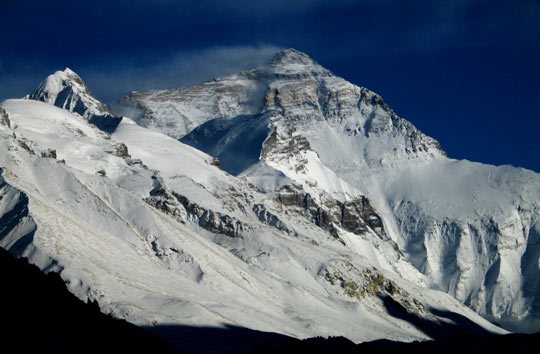
Mt. Everest, viewed from the north side. China has recently issued a ban on climbing on the north face until May 10, 2008, in preparation for the Olympic torch run to Everest’s summit, and it has urged Nepal to issue a similar ban on climbing on the south side. [Photo] Brad Clement / Spindrift Films
It is still unclear when climbers will be able to attempt Mt. Everest this season after The China Tibet Mountaineering Association (CTMA) issued a climbing ban for the north side of Everest and the entirety of Cho Oyu until May 10, 2008, and requested that Nepal issue a similar ban for the south side.
According to a published statement on www.mounteverest.net, the CTMA’s reasons for imposing the ban include “concern of heavy climbing activities, crowded climbing routes and increasing environmental pressures.” These reasons, they cited, “will cause potential safety problems in Qomolangma [Mt. Everest] areas (included Mt. Cho Oyu) in this Spring season.”
Although the CTMA labels safety and crowd concerns as reasons for the ban, many climbers, expedition leaders and pro-Tibet supporters believe that the restriction is China’s attempt to improve its image before it hosts the XXIX Olympic Games this summer in Beijing. The Olympic torch is scheduled to reach the summit of Mt. Everest before arriving in Beijing, and a ban on both sides would ensure that China could control the path, clearing the mountain of protesters and pro-Tibet demonstrations. Recent protests and violence in Tibet have brought China under world scrutiny for its more-than-fifty-year occupation of Tibet.
Both Nepalese and Chinese officials have made contradictory statements about the ban and its details. The Chinese government has not provided further details since the initial ban issued on March 10, 2008, which said that climbers would not be allowed to go to Everest Base Camp until May 10. However, the Nepalese Ministry of Culture, Tourism and Civil Aviation (MoCTCA) issued a press release on March 18, stating that the MoCTCA has not banned any climbing expeditions from Mt. Everest or any other Himalayan peaks. This is contradictory to a statement issued on March 19, by Nepal’s Ministry of Tourism that said climbers would be allowed up to Camp 2 until May 1, but they would be required to “rest” in Base Camp from May 1-10. They assured that starting on May 11, access to the mountain would be unrestricted.
The ambiguity poses problems for climbers and guiding companies. The South Col route of Everest, accessed through Nepal, is the most common and easier way to summit; if Nepal agrees to China’s request to close the south side from now until May 10, the summit window would be shortened significantly. Historically, there have been very few summits in June because the Khumbu icefall, which climbers pass through multiple times when acclimatizing, melts, making seracs unstable and increasingly more dangerous. If the mountain is closed to climbers until May 10, acclimatizing would be very difficult, and Sherpas would not have the time to fix ropes for the usual summit window of mid to late May. Based on recent updates, this situation seems unlikely and if climbers are only banned from Everest’s high camps from May 1-10, summit bids shouldn’t be drastically affected.
The Chinese-controlled Tibetan north side of Everest has more challenging climbing than the south side, but the North Col route would be the best option for climbers if a complete south side ban is enforced because the summit window is longer. In 2007, fourteen people summited the North Col route on June 5, and another fourteen summited that route on June 14.
Adding to the confusion, Tibet currently is closed to tourists, and Lhasa is under curfew because of recent violence. If Nepal agrees to ban climbing on the south side and climbers are allowed to climb from the north side, they will face what is perhaps a moral dilemma. Canceling trips from the south side would divert money away from the Nepalese economy and the Sherpa people, who depend on tourism, and route those dollars to China.
Both of the above situations are only hypothetical. It seems that China will keep its ban on climbing on the north side until May 10, and that Nepal will only ban climbing in the high camps from May 1-10, which would not greatly interfere with acclimatizing and summit attempts.
In the past fifteen years, the prevailing ethics on Everest seem to have changed as stories of theft and greed (see the March 12, 2008 Weekly Feature), inexperienced clients short-roped to the summit, and dying climbers stepped over on summit bids (see Issue 17’s Editor’s Note) become more common in the media. In 2006, more than 450 climbers summited Everest, and in 2007 that number jumped to almost 600, more than six times the number of successful climbers in 1996. Although the south side appears to be the best option for climbing Everest this season, the already-crowded mountain could become even more turbulent and dangerous if climbers flock to one side for their summit attempts.